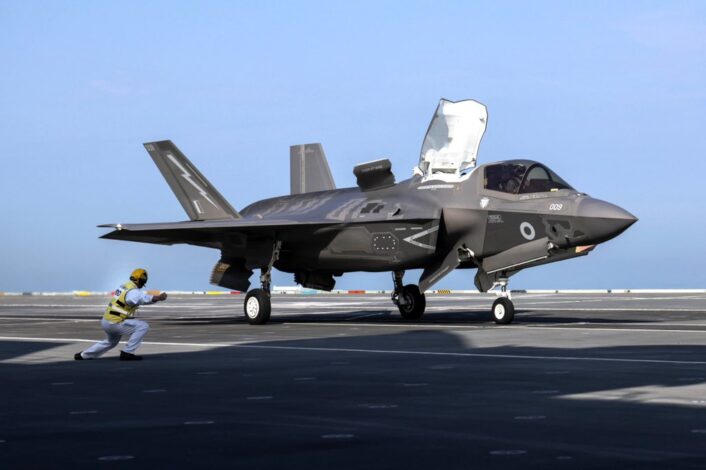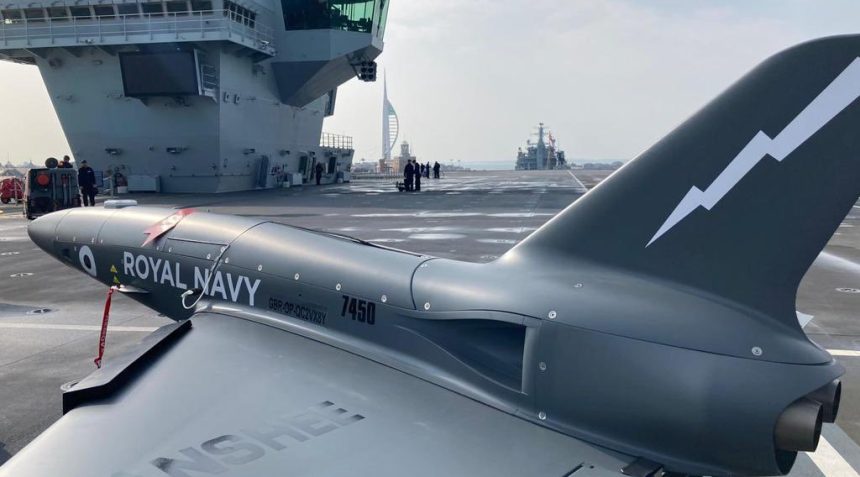The aircraft carrier is testing the Banshee target drone as a training, testing and evaluation method for simulating airborne targets at sea ahead of the participation to Exercise Joint Warrior.
The HMS Prince of Wales is at sea again on the way to the Scottish coast, where she will take part to Exercise Joint Warrior, scheduled from Sept. 27 to Oct. 4, 2021. The Royal Navy is moving at a fast pace to get the second aircraft carrier of the Queen Elizabeth class fully operational and ready for deployment, after the F-35B Lightning II first landed on the ship in June 2021.
Earlier this summer, the HMS Prince of Wales was involved in the Sea Acceptance Trials, testing the ship’s capability to receive and launch aircraft and sustain continuous air operations. In addition to the Royal Navy Merlin and Wildcat helicopters and the Royal Air Force F-35B, the carrier also launched and recovered Chinook and Apache helicopters, before completing Basic Sea Training and sailing for a quick visit to Gibraltar.
New Toy Day for #PWLSAtSea! We’re testing “Banshee” by @QinetiQ as a training, testing and evaluation method for simulating airborne targets at sea.
Capable of up to 200meters per second, it’s twin gas turbines mean it’s pretty quick!
✈️✈️💨💨🎯🎯 pic.twitter.com/KobVRHSUEV
— HMS Prince of Wales (@HMSPWLS) September 2, 2021
Operating crewed and un-crewed air assets in the shape of @thef35 and the Banshee from @QinetiQ is another big step forward on our journey to joint carrier strike capability.
They also look pretty cool!
✈️✈️🛩🛩😎😎@OC207Sqn @RAF_Marham pic.twitter.com/PlbnpQJFRC
— HMS Prince of Wales (@HMSPWLS) September 8, 2021
More recently, at the beginning of September, the ship’s official Twitter account disclosed the beginning of a test campaign with the QinetiQ Banshee target drone, which is being evaluated for a training, testing and evaluation method for simulating airborne targets at sea. The post shows a twin-engine drone, mentioning that it can reach speeds up to 200 metres/second (about 388 knots) and thus allowing us to identify it as the Banshee Jet 80+. The Banshee is fitted with two gas turbine engines that provide 45 kg of thrust each, for a total of 90 kg of static thrust. Fitted with an auxiliary fuel tank, the drone can fly for more than 45 minutes with a range of more than 100 km.
The Banshee can be fitted with an IR Hot Nose to provide, together with the engines’ own IR signature, an all-aspect Infra-Red source to act as a realistic target for IR-guided weapons. Another possible payload is the Rattler Ground Air-Launched Supersonic Target, designed to realistically replicate air-launched Anti-Radiation Missiles (ARMs) and Supersonic High-Diver threats and capable of speeds of between Mach 1.8 to Mach 2.5. Neither of those payloads was tested aboard the HMS Prince of Wales, according to the photos published by the Royal Navy. We did however notice that the Banshee, after the first days onboard with the classic orange livery usually seen on target drones, is now wearing a Royal Navy Fleet Air Arm grey livery.

It is not known at this time if the tests with the Banshee are in some way related to Project Vixen, the project that aims to create an autonomous carrier-launched wingman. This program presents many similarities with the Royal Air Force Project Mosquito, part of the bigger Lightweight Affordable Novel Combat Aircraft (LANCA) concept that will offer increased protection, survivability and information for the manned aircraft. One of the focus points of the program is to create a drone costing approximately £ 10M or a tenth of the cost of an F-35B.
According to previous official statements, it is likely that Vixen will be a derivative of Mosquito which has been adapted for carrier operations: “The RAF envisions an aircraft derived from LANCA’s Mosquito phase being used on the Royal Navy’s aircraft carriers alongside F-35B Lightnings”, said last year Air Chief Marshal Mike Wigston, Chief of the Air Staff of the Royal Air Force.
Some clues in a Request For Information (RFI) of the British government for aircraft launch and recovery equipment suggest that Vixen might be catapult-launched and recovered via arrestor cables, in what is commonly known as “cat and trap” system. The document mentions an electromagnetic catapult able to launch aircraft up to a maximum weight of 55,000 pounds (slightly less than the 60,000 pounds Maximum Take-Off Weight of the F-35B) and arrestor solutions for the recovery of aircraft between a maximum of 47,000 pounds and a minimum of 11,000 pounds.
Another interesting detail mentioned in the RFI is that the equipment could be used for both crewed and un-crewed air vehicles and should be ready for installation on the ship within three to five years. The latter detail would also fit the expected timeline for LANCA, which could be first deployed alongside the Typhoon and the F-35 by the end of the decade, before the entry into service of the new Tempest in 2035. As we already reported, the LANCA project was started to understand innovative combat air technologies and concepts under the Future Combat Air System Technology Initiative (FCAS TI), the same programme which generated the Tempest 6th generation aircraft.









